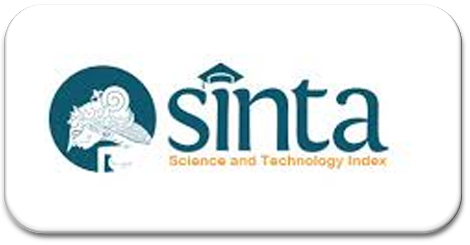PELATIHAN KOMUNIKASI UNTUK MENINGKATKAN PENGETAHUAN MEMBERIKAN FEEDBACK PEGAWAI PANTI DINAS SOSIAL DIY
Abstract
Full Text:
PDFReferences
Ajzen. (2005). Attitudes, Personalitiy, and Behavior. New York: Open University Perss.
Arikunto, S. (2010). Prosedur Penelitian Suatu Pendekatan Praktik. Edisi Revisi 10. Jakarta: PT. Rineka Cipta.
Baker, K.A. (2002). Organizational Communication (15 pages). Wren Network. Available FTP: Hostname: www.wren-network.net.
Cahyono (1996). Pendidikan dan Pelatihan Sumber Daya Manusia. Jakarta. Penerbit IPWI.
Cummings, T.G. & Worley, C.G. (2009). Organizational Development and Change (9th ed). Ohio: South-Western Cengage Learning.
De Janasz, S.C. Dowd K.O & Scheider.B.(2002) Interpersonal Skills in Organization. Singapore: McGraw-Hill
De Vito. (1997). Komunikasi Antar Manusia. Jakarta: Profesional Books.
Effendy. (1994). Dinamika Komunikasi. Bandung: PT. Remaja Pusdakarya.
-----------(1989).Kamus Komunikasi.Bandung :PT. Remaja Pusdakarya.
Frandawati. (2011). Kajian Efektifitas Komunikasi Atasan Bawahan Pada Karyawan Hotel X. Tesis. Medan
Gibson, dkk. (2006). Communication at Work. New York: McGraw-Hill.
Hackman, J.R. & Oldham, G.R. (1976) Motivation Through the desain of work: Test OD a Theory. Organozational Behavior and Human Performance, 16: 250-279.
Hardjana, A. M. (2003). Komunikasi Intrapersonal & Interpersonal. Jakarta: Kanisius.
Hariandja, M.T. (2002). Manajemen Sumber Daya Manusia: Pengadaan, Pengembangan, Pengkompensasian dan Peningkatan Produktivitas Pegawai. Jakarta: Grasindo Widiasarana Indonesia.
Harsono. (1988). Coaching dan Aspek-Aspek Psikologis Dalam Coaching. Jakarta: CV. Tambuk Kusuma.
Ivancevich. (2008). Human Resource Management. New York: McGraw-Hill.
Ian, (2010). Pengertian pengetahuan. Diunduh dari: http://ian43.wordpress.com. 25 Oktober 2013
Jewell, L.N., & Siegall, M. (1998) Psikologi Industri Organisasi Modern. Jakarta: Penerbit Arcan
Johlke, M.C., & Duhan, D.F. (2000). Supervisor Communication Practices and Service Employee Job Outcomes.Journal of Service Research.
Kathleen, A. B. (2007). Impact of communication training on physician behavior and patient perceptions. Dissertation.
Kreps, G. L. (1986). Organizational Communication: Theory and Practice. New York: Longman.
Liliweri (1994). Perspektif Teoritis, Komunikasi Antar Pribadi (Suatu Pendekatan Ke Arah Psikologi Sosial Komunikasi). Bandung, PT Citra Aditya Bakti
Lestari. E.G& Maliki. (2003). Komunikasi yang Efektif. (Modul Pendidikan Dan Pelatihan), LAN-RI.
Mangkuprawira, S. (2004). Manajemen Sumber Daya Manusia Strategik. Jakarta Selatan: Ghalia Indonesia.
Mathis & Jackson. (2002). Human Resource Management (9th ed). USA: Cengage Learning.
Nicola. J. H. & Ian M. F. (2001). Pengaruh interaksi terhadap instruksi dan feedback dalam mempelajari keterampilan koordinasi. Tesis.
Noe, dkk. (2003). Human Resource Management: Gaining a competitive advantage. Fourth Edition. USA: McGraw-Hill
Notoatmodjo. S. (2003). Pendidikan dan Perilaku Kesehatan. Jakarta. PT. Asdi Mahasatya.
Patria, G. (2004). Pengaruh feedback supervisor terhadap kinerja tenaga penjualan. Tesis.
Partowisastro (1983). Dinamika dalam Psikologi Pendidikan. (Jilid I). Jakarta: Erlangga.
Pia, S.W. (1997). Efektivitas umpan balik menurut pandangan bawahan yang berkaitan dengan gaya komunikasi yang digunakan atasan langsungnya. Tesis.
Prijaksono A. R & Sembel. (2002) Komunikasi efektif. Sinar Harapan. (online). Diunduh dari http.www.sinarharapan.co.id/sumber.20 Maret 2013.
Randal, R. & Arnold, J. (2010). Work Psychology: Understanding Human Behavior in the Workplace. London: Pearson Education Limited.
Rogelberg.S.G.(2004). The Encyclopedia of Industrial and Organizational.Charlotte. University of North Carolina.SAGE Publications, Inc
Rusli, L. (1998). Perencanaan dan Strategi Pembelajaran Penjaskes.PPGK-2536 Jakarta.
Rink, J.E. (1985). Teaching Physical Education for Learning. ST. Louis: Times Mirror/Mosby.
Riggio.R.E. (2008). Introduction to Industrial and Organizational Psychology, 5/E, Pearson
Soenarto.A. (2007). Communication Games untuk Pelatihan Manajemen. Yogyakarta: Andi Publisher
Sudjana, N & Ibrahim. (2001). Penelitian dan Penilaian Pendidikan.Bandung: Sinar Baru Algesindo.
Sudjana (2010). Evaluasi Proses dan Hasil Pembelajaran. Jakarta: Bumi Aksara.
Suranto (2006). Komunikasi Efektif untuk Mendukung Kinerja Perkantoran.Diunduh dari www.uny.ac.id.9 Februari 2013.
Silberman, Melvin. (2006). Active Learning 101 Cara Belajar Siswa Aktif. Yogyakarta: Pustaka Insan Madani.
Sutrisno.H.(1991). Analisa Butir Untuk Instrumen Angket, Test, dan Skala Rating.Yogyakarta. Penerbit Andi Offeset.
Suriasumantri. S. J. (2000). Filsafat Ilmu: Sebuah Pengantar Populer. Jakarta. Pustaka Sinar Harapan.
Sendjaja. (1994). Teori-TeoriKomunikasi. Jakarta: Universitas Terbuka.
Stoner, J. & Freeman, (1994). Manajemen.Jilid 2. Edisi Ke-5. Alih Bahasa: Wilhelmus W. Bakowatun & Benyamin Molan. Jakarta: Erlangga.
Usman.(2002). Menjadi Guru Profesional. (Cet. XIV). Ed. II. Bandung: PT. Remaja Rosdakarya
DOI: http://dx.doi.org/10.22373/psikoislamedia.v1i2.916
Refbacks
- There are currently no refbacks.
Copyright (c) 2017 syahrizal syahrizal
Published by Faculty of Psychology UIN Ar-Raniry
Journal Secretariat:
Jl. Syeikh Abdur Rauf, Fakultas Psikologi, Kopelma Darussalam UIN Ar-Raniry, Banda Aceh, 23111,
e-mail: [email protected]
INDEXED BY:

This work is licensed under a Creative Commons Attribution-ShareAlike 4.0 International License.





_(1).png)
1_(1).png)
_(1).png)








.png)